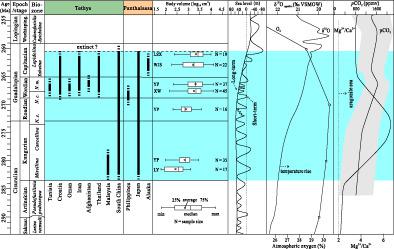当前位置:
X-MOL 学术
›
Geolog. J.
›
论文详情
Our official English website, www.x-mol.net, welcomes your
feedback! (Note: you will need to create a separate account there.)
The implications of the giant bivalve family Alatoconchidae for the end-Guadalupian (Middle Permian) extinction event
Geological Journal ( IF 1.4 ) Pub Date : 2021-04-19 , DOI: 10.1002/gj.4151 Fayao Chen 1, 2 , Wuqiang Xue 1, 2 , Jiaxin Yan 1, 2 , Qi Meng 1, 2
Geological Journal ( IF 1.4 ) Pub Date : 2021-04-19 , DOI: 10.1002/gj.4151 Fayao Chen 1, 2 , Wuqiang Xue 1, 2 , Jiaxin Yan 1, 2 , Qi Meng 1, 2
Affiliation

|
The end-Guadalupian extinction is an important biotic event in the Phanerozoic with an ecological impact comparable to the ‘big five’ extinctions. However, the age, pattern, and mechanism of this extinction are all under debate. The bivalves of the Alatoconchidae family attained body volumes up to 10,000 cm3 and had a wide distribution in the low latitude Palaeotethys and Panthalassa. These giant clams originated in the early Kungurian and went extinct in the Late Guadalupian. Therefore, they are the typical victims of the end-Guadalupian extinction and are major index fossils for the understanding of this event. Although extraction of these giant bivalves from the host-resistant limestone is hard, plenty of new-found transverse sections on outcrops are available for morphological reconstruction and volume estimation. The measurement from the representative fossil localities in South China indicates the clams achieved a substantial volume increase during the Wordian and sustained the giant size to the late Capitanian, till their abrupt disappearance. The giant clams originated under atmospheric hyperoxia and warm climate after the Late Palaeozoic Ice Age. Their body volume increase was roughly parallel to the seawater warming. The accompanied high seawater carbonate saturation and Mg/Ca ratio are beneficial to their biomineralization of the large shells with aragonite or high-Mg calcite components. On the contrary, these giant bivalves were probably killed by the major or rapid changes of those environmental factors that once facilitated their success, such as drastic fluctuation of seawater temperature, sudden ocean acidification, and marine anoxia.
中文翻译:

巨型双壳类家族 Alatoconchidae 对瓜达鲁普纪末期(中二叠纪)灭绝事件的影响
瓜达鲁普纪末期大灭绝是显生宙的一个重要生物事件,其生态影响可与“五大”大灭绝相媲美。然而,这种灭绝的年龄、模式和机制都在争论中。Alatoconchidae 科的双壳类动物体体积达到 10,000 cm 3并广泛分布于低纬度古特提斯和潘塔拉萨。这些巨蛤起源于昆古尔纪早期,在瓜达鲁普纪晚期灭绝。因此,它们是瓜达鲁普末期灭绝的典型受害者,是了解这一事件的主要指标化石。虽然从耐寄主的石灰岩中提取这些巨型双壳类动物很困难,但大量新发现的露头横断面可用于形态重建和体积估计。对华南具有代表性的化石产地的测量表明,蛤蜊在 Wordian 期间实现了大幅增长,并保持了巨大的体型,直到 Capitanian 晚期,直到它们突然消失。巨蛤起源于晚古生代冰河时代之后的大气高氧和温暖气候。他们的身体体积增加与海水变暖大致平行。伴随的高海水碳酸盐饱和度和 Mg/Ca 比有利于其具有文石或高镁方解石组分的大壳的生物矿化。相反,这些巨大的双壳类动物很可能被那些曾经促进它们成功的环境因素的重大或快速变化所杀死,例如海水温度的剧烈波动、突然的海洋酸化和海洋缺氧。伴随的高海水碳酸盐饱和度和 Mg/Ca 比有利于其具有文石或高镁方解石组分的大壳的生物矿化。相反,这些巨大的双壳类动物很可能被那些曾经促进它们成功的环境因素的重大或快速变化所杀死,例如海水温度的剧烈波动、突然的海洋酸化和海洋缺氧。伴随的高海水碳酸盐饱和度和 Mg/Ca 比有利于其具有文石或高镁方解石组分的大壳的生物矿化。相反,这些巨大的双壳类动物很可能被那些曾经促进它们成功的环境因素的重大或快速变化所杀死,例如海水温度的剧烈波动、突然的海洋酸化和海洋缺氧。
更新日期:2021-04-19
中文翻译:

巨型双壳类家族 Alatoconchidae 对瓜达鲁普纪末期(中二叠纪)灭绝事件的影响
瓜达鲁普纪末期大灭绝是显生宙的一个重要生物事件,其生态影响可与“五大”大灭绝相媲美。然而,这种灭绝的年龄、模式和机制都在争论中。Alatoconchidae 科的双壳类动物体体积达到 10,000 cm 3并广泛分布于低纬度古特提斯和潘塔拉萨。这些巨蛤起源于昆古尔纪早期,在瓜达鲁普纪晚期灭绝。因此,它们是瓜达鲁普末期灭绝的典型受害者,是了解这一事件的主要指标化石。虽然从耐寄主的石灰岩中提取这些巨型双壳类动物很困难,但大量新发现的露头横断面可用于形态重建和体积估计。对华南具有代表性的化石产地的测量表明,蛤蜊在 Wordian 期间实现了大幅增长,并保持了巨大的体型,直到 Capitanian 晚期,直到它们突然消失。巨蛤起源于晚古生代冰河时代之后的大气高氧和温暖气候。他们的身体体积增加与海水变暖大致平行。伴随的高海水碳酸盐饱和度和 Mg/Ca 比有利于其具有文石或高镁方解石组分的大壳的生物矿化。相反,这些巨大的双壳类动物很可能被那些曾经促进它们成功的环境因素的重大或快速变化所杀死,例如海水温度的剧烈波动、突然的海洋酸化和海洋缺氧。伴随的高海水碳酸盐饱和度和 Mg/Ca 比有利于其具有文石或高镁方解石组分的大壳的生物矿化。相反,这些巨大的双壳类动物很可能被那些曾经促进它们成功的环境因素的重大或快速变化所杀死,例如海水温度的剧烈波动、突然的海洋酸化和海洋缺氧。伴随的高海水碳酸盐饱和度和 Mg/Ca 比有利于其具有文石或高镁方解石组分的大壳的生物矿化。相反,这些巨大的双壳类动物很可能被那些曾经促进它们成功的环境因素的重大或快速变化所杀死,例如海水温度的剧烈波动、突然的海洋酸化和海洋缺氧。











































 京公网安备 11010802027423号
京公网安备 11010802027423号